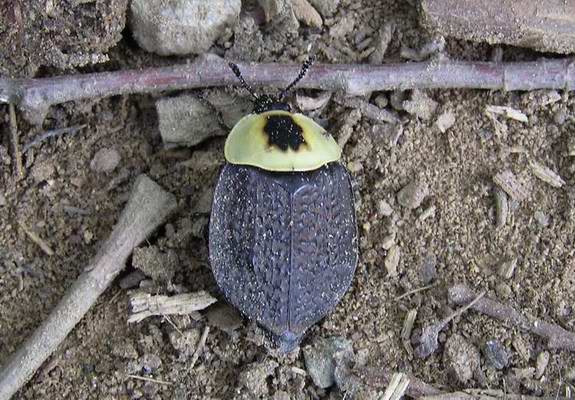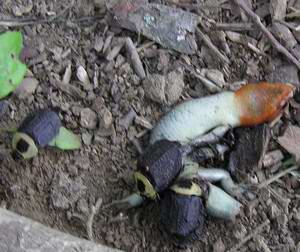|
Return to Hiker's Notebook Home Page
Common Name: American Carrion Beetle - Named for its primary carrion food source consisting of the dead and putrefying flesh of animals. American emphasizes that it is endemic to North America east of the Rocky Mountains. Carrion comes from the Latin word caro meaning flesh.
Scientific Name: Necrophila americana - The generic name if from the Greek nekros, meaning "dead body" and philos, meaning "loving" in reference to its primary food source. The species name is a Latinized form to reflect its American provenance. Formerly designated Silpha americana.
The American Carrion Beetle is one of the primary agents in the dispatch of dead animal carcasses that would otherwise succumb only to the slow but inexorable procession of mephitic bacterial putrefaction. Although they may be followed and dispersed by their larger carrion-eating scavengers like the black and turkey vultures, carrion beetles are among the first to arrive at the scene of death, preceded only by the ubiquitous flies. All carrion feeders depend on bacteria to initiate the process. When an organism dies, its innate defensive chemistry ceases and the resident heterotrophic bacteria begin the process of decomposition. Bacterial decomposition is essentially a respiratory process in which complex hydrocarbons and amino acid proteins are oxidized to produce carbon dioxide, water and other constituent molecules. The bacteria are responsible (with the fungi) for recycling the complex chemistry of dead living things into the simple constituent atoms that are then available for the metempsychosis of reincarnation. Among the products of bacterial decomposition are two very similar toxic diamine (having two NH2 molecules) molecules aptly named cadavarine and putrescine. It is these substances that broadcast the presence of a carrion to the flies, the beetles and the vultures. Cadavarine and putrescine are the putrescent smell of a cadaver. Due to their mobility, the flies are the first to reach the source of the decomposition smell; on arrival their first act is to lay eggs. This evolved survival tactic takes advantage of the nutrient rich organic matter that is initially free of predators or competition. The eggs hatch within hours (another adaptation) into white larvae that are called maggots, the second metamorphic stage of dipterous insects. For a few hours, the maggots and the adult flies (who may also eat some carrion) share the feast only with the bacteria; the fly larvae instinctually burrow into the carcass as a matter of survival. All is well until carrion beetles arrive, ultimately dependent on and drawn to the same carcass for sustaining their own procreative success. Carrion beetles eat fly maggots. It is a matter of some conjecture whether they eat the maggots for nutrition or whether they actively seek to reduce the competition for their own carrion beetle progeny. They soon mate and lay eggs which hatch into larvae. The voracious carrion beetle larvae feed not only on the fly larvae, but also on the carrion in which they are both embedded. On growth and satiation, the carrion beetle larvae drop from the carcass and burrow underground for pupation, emerging about three weeks later as adults to seek out new maggot-infested carrion.
There is a third party to the carrion beetle � maggot resource relationship that fills an unusual niche in the web of life. Eight-legged arachnid mites of the genus Poecilochirus employ phoresy in their attachment to the beetle�s dorsal folded wing covers called elytra. Phoresy is a type of mutual relationship in which one organism uses another for transportation. The transported mites jump off the beetle and onto the carrion to eat fly eggs and maggots. As there are many more fly eggs and maggots than either beetles or mites could consume, the process constitutes a boon to the beetles and a free lunch to the mites. The mites sustain the association by either regaining their elytra positions on the adult beetles that transported them there or by waiting for the next generation to emerge from the adjacent pupate metamorphosis of the next beetle generation.
The family Silphidae is comprised of the sub-family Silphinae, the carrion beetles, and Nicorphorinae, the burying beetles; both depend on dead animals for their nutrition. They are distinguished according to their behavior. Carrion beetles, as delineated above, feed on fly maggots deposited in relatively large carcasses and bear no responsibility for their young; the eggs hatch, the larvae eat and pupate to adults. Burying beetles are aptly named. They assiduously bury relatively small animal carcasses by digging out the soil underneath them and covering them over to prevent fly infestation. Oviposition follows as eggs are laid on the now isolated food source that becomes virtually the sole providence of the beetle and the hatched larvae, which the adults care for until pupation. |

